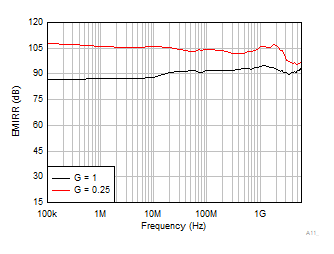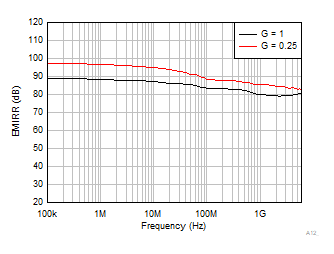SBOSAI9B December 2023 – March 2024 INA500
PRODMIX
- 1
- 1 Features
- 2 Applications
- 3 Description
- 4 Device Comparison Table
- 5 Pin Configuration and Functions
- 6 Specifications
- 7 Detailed Description
- 8 Application and Implementation
- 9 Device and Documentation Support
- 10Revision History
- 11Mechanical, Packaging, and Orderable Information
Package Options
Refer to the PDF data sheet for device specific package drawings
Mechanical Data (Package|Pins)
- DBV|6
- DCK|6
Thermal pad, mechanical data (Package|Pins)
Orderable Information
7.3.3 EMI Rejection
The INA500 uses integrated electromagnetic interference (EMI) filtering to reduce the effects of EMI from sources such as wireless communications and densely-populated boards with a mix of analog signal chain and digital components. EMI immunity can be improved with circuit design techniques; the INA500 benefits from these design improvements. Texas Instruments has the ability to accurately measure and quantify the immunity of an operational amplifier over a broad frequency spectrum extending from 10MHz to 6GHz. Figure 7-81 shows the results of this testing on the INA500 for differential EMI interference and Figure 7-5 shows the results of this testing on the INA500 for common-mode EMI interference. Table 7-2 provides the EMIRR IN+ values for the INA500 at particular frequencies commonly encountered in real-world applications. The EMI Rejection Ratio of Operational Amplifiers application report contains detailed information on the topic of EMIRR performance relating to op amps and is available for download from www.ti.com.
 Figure 7-4 Electromagnetic Interference
Rejection Ratio Referred to Output vs Frequency (Differential Input)
Figure 7-4 Electromagnetic Interference
Rejection Ratio Referred to Output vs Frequency (Differential Input) Figure 7-5 Electromagnetic Interference Rejection Ratio Referred to Output vs Frequency
(Common-Mode Input)
Figure 7-5 Electromagnetic Interference Rejection Ratio Referred to Output vs Frequency
(Common-Mode Input)| FREQUENCY | APPLICATION OR ALLOCATION | EMIRR DIFFERNTIAL | EMIRR COMMON-MODE |
|---|---|---|---|
| 400MHz | Mobile radio, mobile satellite, space operation, weather, radar, ultra-high frequency (UHF) applications | 91dB | 83dB |
| 900MHz | Global system for mobile communications (GSM) applications, radio communication, navigation, GPS (to 1.6GHz), GSM, aeronautical mobile, UHF applications | 98dB | 82dB |
| 1.8GHz | GSM applications, mobile personal communications, broadband, satellite, L-band (1GHz to 2GHz) | 101dB | 80dB |
| 2.4GHz | 802.11b, 802.11g, 802.11n, Bluetooth®, mobile personal communications, industrial, scientific and medical (ISM) radio band, amateur radio and satellite, S-band (2GHz to 4GHz) | 95dB | 78dB |
| 3.6GHz | Radiolocation, aero communication and navigation, satellite, mobile, S-band | 88dB | 79dB |
| 5GHz | 802.11a, 802.11n, aero communication and navigation, mobile communication, space and satellite operation, C-band (4GHz to 8GHz) | 94dB | 80dB |